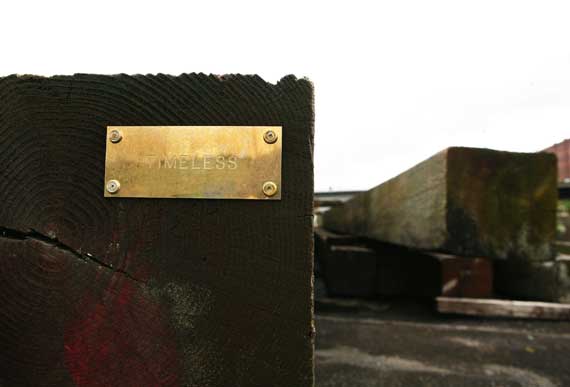|
|



| Eleven
Minutes (Lost Time Pieces) |

A group
of artists, known collectively as Nova Group, produced a collection of ‘time-pieces’ suggested
by, and representing, the eleven minutes lost to Bristol when ‘Railway
Time’ was introduced.
During Brunel’s lifetime, mechanically-kept time and instrumentation
developed into something of the utmost importance. The Victorian railways
led to the introduction of standard ‘Railway Time’ or 'London
Time' throughout the country. For some years after the building of the
GWR, published timetables specified a different adjustment for each station
on the line.
In Bristol's case, this adjustment was 11 minutes. Each
station had two clocks; one showing local time, while the other hand
pointed to 'Railway Time'. Occasionally clocks were fitted with an additional
minute hand, which pointed to the local time, while the other hand pointed
to 'Railway Time'.

On
14 September 1852, Bristol formally adopted uniform standard time; all
the clocks went forward, erasing the time difference and the cause of
much confusion. From then on, the city's timepieces were controlled,
not by the sun, but by the Greenwich Observatory.
In response to the ‘loss’ of 11 minutes, Nova produced sculptures
and installations incorporating a variety of media, including metal,
wood, ‘redundant’ items already in situ, light and audio.
Most
of the pieces included an element of movement, some were based on ‘lost’ means of time-keeping e.g. sand and water. The
pieces were of ambiguous function, part time-piece, part unidentifiable
scientific or navigational instrument, and were sited in relatively obscure, ‘abandoned’ spaces,
within the Brunel-linked landscape of the western Floating Harbour. The
installations embodied the essence of the machines of the early 19th
century, but were ‘out-of-time’, enigmatic constructions.

This
project by NOVA,
“…presents a journey through those
lost or displaced minutes. Into the lost 'time-bubble' was sucked the
essence and spirit of the age, including some of the essence of Brunel
– as summed up by instruments, machines, time-pieces etc. These have
now re-emerged in our time as strange and ambiguous altered states –
scattered remnants from the void occupying forgotten spaces in the city.
Neither Frankenstein nor Heath-Robinson, these fusings retain a sense
of elegance and poetry, if not obvious purpose and functionality.
The locations exhibit an atmosphere of tension between
old and new, past and present. Walking the route, one passes through
residual layers of history, offering an opportunity for contemplation
on the nature and direction of industrial progress, and some of its
contemporary resonances.”
The pieces were installed at the following
locations:
• The Nova Scotia Ferry Jetty
• Cumberland Basin – south side, grassy area
• Under the Plimsoll Bridge – in the area surrounding Brunel’s
old swing bridge
• Notice Board on the ‘promontory’, near Brunel’s
old swing bridge
• Timbers adjacent to grid-iron, and across the Brunel Lock on ‘Spike
Point’
• End of Spike Island
• Outer Sluice ‘hut’ on the ‘Chocolate Path’
• Underfall Yard – near the north entrance
Three further pieces were installed in the CREATE Centre as part
of an indoor exhibition.
Since the installation, several of the pieces
have been left as permanent reminders of the project. They will decay gently
over a number of years, their deterioration contributing to the look
of the work and the enigma of the intention behind their construction.
One, the notice board on the promontory near Brunel’s swing bridge,
has been converted to enamel panels, giving them permanency for local
residents and visitors to enjoy.

Quotes and feedback from visitors included
“I really loved the trail; I brought my
family down the following day to show them the wonderful creations.”
“I’ve never been down here…. And I’ve lived
in Bristol for 20 years. It’s a wonderful discovery.”
“I’ve been wanting to do something with that noticeboard
for ages… do you think you could make the piece permanent?”
Bristol
Dock Master
...and many more.

Map of route. Click on the map to see a larger
version.
Artists from the NOVA group said
“It has been an honour to be
part of a major celebration for Bristol, and Brunel. In-depth research
as part of the art project has opened our eyes not just to the life and
works of a prominent individual, but to the era as a whole.”
Photography: Mark
Simmons.
|
|